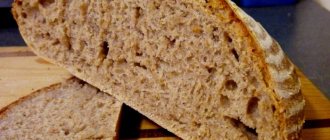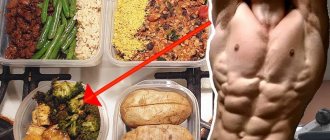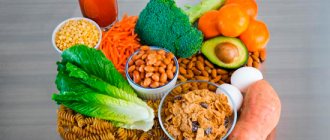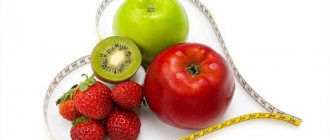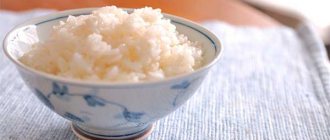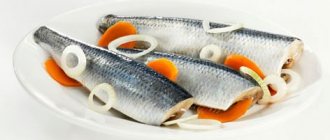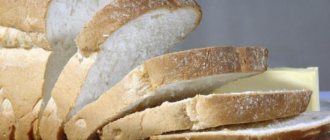Carbohydrates make you lazy
Indeed, muscles grow better from proteins and carbohydrates - without carbohydrates they grow very difficult. However, there are strength training practices, such as CrossFit with the paleo diet, where carbohydrates are treated with contempt: “carbohydrates make the body lazy.” This is also true.
The hardest part is finding the balance between training and carbohydrates. A lack of carbohydrates takes away strength, and too much.
I learned that a lack of carbohydrates makes muscles sluggish and weak when I was preparing for a bodybuilding competition on carbohydrate fasting days. All competitive bodybuilders know that without carbohydrates, muscles weaken, and it is generally difficult to think about their growth.
However, if you are really loaded with carbohydrates, then you don’t want to train at all - you want to sleep. This is why bodybuilders who “constantly bulk up” - overeat on carbohydrates - often advocate for infrequent and short-term workouts.
Young people who look at “mass” bodybuilders and listen to the advice of consultants in sports nutrition stores blindly drink megagainers, become lazy, and then fat. Of course, they become bigger and even stronger, but body weight grows inadequately to the growth of strength, and more fat will be gained than muscle.
Diet for gaining muscle mass
The diet of a modern person has the following ratio of nutrients: 60% - carbohydrates, 30% - fats, 10% - proteins. In fact, the last two indicators should switch places! This is a prerequisite for the growth of muscle mass; fats must be reduced to a minimum, while increasing the consumption of protein foods by 3 times. Those. the ratio of foods consumed should be as follows: 60% carbohydrates, 30% proteins and only 10% fats.
Eat every 2-3 hours to quickly support your metabolism. By doing this, you will burn your food faster, making you feel hungry and less full. There are many supplements you can take to increase your appetite and metabolism. A fat burner in a small dose will not hinder your progress, but it will make you a little nervous and hungry.
Additionally, caffeine and similar energy-boosting supplements will help create a greater appetite. Always remember that if you don't feel like eating and quit, then it's wise to take another 1 hour of free time to eat. Listen to your body and it won't hurt you.
In this way, you can not only start gaining quality mass, but also greatly change the state of your body.
To prevent carbohydrates from interfering with your workout
I'll tell you a little secret. In order for carbohydrates not to interfere with your workout, you need to be a little hungry - not faint from hunger, but a little hungry.
I train every day, so every day I go into a state of mild malnutrition and high performance. If you train three times a week, then you need to enter this state at least three times a week - before each workout.
In normal life, I burn about 100 calories per hour, so I eat one hundred calories for every hour before training. For example, to be in working condition, I eat 800 kilocalories eight hours before the first set of push-ups or pull-ups. Not more!
Amount of food to gain muscle mass
To start the anabolism process, the most important rule is: You must consume more calories than your body expends.
. Those. the intake of nutrients must prevail over their combustion.
While diet, training and rest are key, supplements can play an important role in bulking up. They will give you the extra boost you need. By taking supplements, you can increase your profits. Nothing dramatic, but still worth the expense to add. They can give you an extra boost when you need it in the weight room or shorten your recovery time.
There you will find everything you need, filled with many items and places that can give you a very close look into the world of add-ons. Even though these famous supplements are very effective and not that expensive. No matter how hard you try, there is no substitute for good whey. It has a fast digestion rate and comes in a very pure form.
Every day you should gradually increase the number of foods you eat until your weight gain gets off the ground. A high-quality set of muscle mass is 500-800 grams per week. If the weight does not increase within three days, you should increase the diet even more; if the weight increases by more than a kilogram per week, you should hold your horses, this way you can gain excess weight in the form of fat deposits. Therefore, if you still don’t have a good electronic scale, it’s time to go to an electronics store. Weighing yourself daily on an empty stomach, after going to the toilet, should become your tradition.
Whey is essential post-workout as your muscles are tired and in need of replenishment. Also when you wake up, whey is the best choice for protein in my opinion. Creatine is used by tons of people all over the world. It is safe, 100% natural and effective. From Olympians to gym rats, people use creatine.
This gives additional impetus during development. It will also help you increase muscle size and improve your lifts. Creatine is ideal for weightlifters, creatine is essential for bulking. This is a 100% natural and safe supplement. It is used mainly for recovery. This can help you recover faster from a leg or back workout you've had.
Most of what you eat during the day should occur BEFORE lunch, because... It is in the first half of the day that the body has maximum enzymatic potential, increased testosterone and other good things that allow the resulting food to be fully absorbed. Larger volume is achieved due to larger portion sizes, i.e. In the morning you don’t have to worry about overeating, but in the afternoon it’s better not to overeat and limit yourself to small but frequent portions.
This way, the intensity and recovery of your workouts are always high. As you bulk up, you need vitamins to maintain your health. With all the training and stress you put on it, it is imperative that you have the vitamins to replenish and repair.
What are the most calories you've eaten in one day when trying in bulk? How did you feel the next day? This was the last week of my massive cycle. Not all night. This experience taught me not to dig and gave me more wisdom for future volumes. You will need to follow a good nutrition plan, good weight lifting, and ensure you get enough rest.
https://youtu.be/wCYMzciG6fo
Eat carbs at night
Enough has been said about how carbohydrates interfere with training. But a lack of carbohydrates makes it difficult to sleep.
Muscles do not grow through training; they get tired and break down during training. Muscles grow while you sleep. It is during sleep that the muscles fill with strength and swell.
If you feel fullness in your muscles in the morning, it means you did everything right. But if you have trouble falling asleep, wake up groggy and lethargic, then you didn’t have enough carbohydrates before bed.
For muscle growth, you need vigor during training and lazy satiety in your sleep. But not the other way around.
Many consultants recommend drinking gainers before training. I do not do that. I eat regular food rich in carbohydrates - rice, potatoes, fruits before bed to help me sleep better.
Don't be afraid to gain fat. If you live within the correct caloric intake, then fat will not accumulate - this is the third law of thermodynamics.
In addition, carbohydrates do not convert into fat well. If you follow the norm both in terms of calories and fats, then you have nothing to fear at all - fat will not increase.
Do you see how many small details you need to take into account to benefit from carbohydrates?!
I don't tell young athletes to "eat more carbs" - I ask them to observe. Each athlete must find for himself the amount of carbohydrates that is needed not only for increasing performance in training, but also for good recovery during sleep.
The benefits of simple carbohydrates in nutrition
Broadly speaking, carbohydrates are divided into complex and simple. They differ only in the speed of absorption by the body.
- Complex carbohydrates take a long time to process and therefore are also called slow carbohydrates.
- Simple ones are processed more quickly and are called fast carbohydrates.
It is not recommended to abuse simple carbohydrates, as they stimulate the growth of fat and are quickly deposited on the sides. But for professional athletes who have set themselves the goal of gaining muscle mass, it is important to consume both types of substances in sufficient quantities.
https://youtu.be/RenRQrOA4PM
Fast carbohydrates are found in abundance in foods such as:
- raisins, dried apricots and other dried fruits;
- baked goods made from wheat flour;
- honey;
- sweet fruits;
- sugar.
The pancreas, which produces insulin, vigilantly monitors sugar levels. When fast carbohydrates and glucose enter our body, they are absorbed into the blood, brain and muscles. In muscle mass, they act to raise muscle energy and slightly increase muscle size by stretching the cells.
If the muscles are already filled with glucose, then its remains are processed into fat cells, which is the main threat from simple carbohydrates for people who do not know what physical activity is.
With athletes the situation is different:
- It is recommended to consume fast carbohydrates one hour before the upcoming workout if you did not have time to eat normally and you urgently need to “recharge”. They will fill the body with energy, which is enough for a vigorous start.
- In addition, they prevent a critical decrease in glycogen levels in muscle tissue, which will help improve training results. Glycogen is actively consumed during strength training aimed at gaining muscle mass.
They also recommend restoring energy after productive workouts in the gym. The first half hour to an hour after the end of an active workout is called the “carbohydrate window” among athletes. During this period, the body is able to very quickly absorb glucose into the blood, obtained from foods rich in fast carbohydrates.
What are complex carbohydrates?
Complex saccharides are natural polymers containing hundreds of molecules of glucose and other monosaccharides. The most common are starch, fiber (cellulose), pectin, and gums (locust bean, guar, xanthan). Because of their ability to bind water and swell, they are often used as thickening agents in cooking and food production.
Such long carbohydrates, under the action of special enzymes, are broken down into simple substances and absorbed by the body. This process occurs gradually, which is why they are called slow sugars.
Important! Some polysaccharides are not digested and are practically not absorbed. These are dietary fibers, which include fiber and pectin. Nevertheless, they play an important role: they stimulate the intestines, act as sorbents, and cleanse the body of toxins.
The main sources of complex carbohydrates are plants: grains, berries and fruits, herbs, vegetables, nuts. There are not many of them in animal products. The polysaccharide glycogen is present in liver and meat.
Table of glycemic indexes of foods
Foods with a high glycemic index (GI=70 and above)
| Product | GI |
| Beer | 110 |
| Dates | 103 |
| Glucose | 100 |
| Modified starch | 100 |
| White bread toast | 100 |
| Swede | 99 |
| Butter buns | 95 |
| baked potato | 95 |
| Fried potatoes | 95 |
| Potato casserole | 95 |
| Rice noodles | 92 |
| Canned apricots | 91 |
| Gluten-free white bread | 90 |
| White (sticky) rice | 90 |
| Carrots (boiled or stewed) | 85 |
| Hamburger buns | 85 |
| Cornflakes | 85 |
| Unsweetened popcorn | 85 |
| Rice pudding with milk | 85 |
| Mashed potatoes | 83 |
| Cracker | 80 |
| Muesli with nuts and raisins | 80 |
| Sweet donut | 76 |
| Pumpkin | 75 |
| Watermelon | 75 |
| French baguette | 75 |
| Rice porridge with milk | 75 |
| Lasagna (soft wheat) | 75 |
| Unsweetened waffles | 75 |
| Millet | 71 |
| Chocolate bar (“Mars”, “Snickers”, “Twix” and the like) | 70 |
| Milk chocolate | 70 |
| Sweet soda (Coca-Cola, Pepsi-Cola and the like) | 70 |
| Croissant | 70 |
| Soft wheat noodles | 70 |
| Pearl barley | 70 |
| Potato chips | 70 |
| Risotto with white rice | 70 |
| Brown sugar | 70 |
| White sugar | 70 |
| Couscous | 70 |
| Semolina | 70 |
Foods with an average glycemic index (GI= 50 to 69)
| Product | GI |
| Wheat flour | 69 |
| Fresh pineapple | 66 |
| Instant oatmeal | 66 |
| Orange juice | 65 |
| Jam | 65 |
| Beets (boiled or stewed) | 65 |
| Black yeast bread | 65 |
| Marmalade | 65 |
| Muesli with sugar | 65 |
| Canned pineapple | 65 |
| Raisin | 65 |
| Maple syrup | 65 |
| Rye bread | 65 |
| Boiled potatoes in their jackets | 65 |
| Sorbet | 65 |
| Yam (sweet potato) | 65 |
| Whole wheat bread | 65 |
| Canned vegetables | 65 |
| Pasta with cheese | 64 |
| Sprouted wheat grains | 63 |
| Wheat flour pancakes | 62 |
| Pizza on thin wheat dough with tomatoes and cheese | 61 |
| Banana | 60 |
| Chestnut | 60 |
| Ice cream (with added sugar) | 60 |
| Long grain rice | 60 |
| Lasagna | 60 |
| Industrial mayonnaise | 60 |
| Melon | 60 |
| Oatmeal | 60 |
| Cocoa powder (with added sugar) | 60 |
| Fresh papaya | 59 |
| Arabic pita | 57 |
| Sweet canned corn | 57 |
| Grape juice (no sugar) | 55 |
| Ketchup | 55 |
| Mustard | 55 |
| Spaghetti | 55 |
| Sushi | 55 |
| Bulgur | 55 |
| Canned Peaches | 55 |
| Shortbread | 55 |
| Basmati rice | 50 |
| Cranberry juice (no sugar) | 50 |
| Kiwi | 50 |
| Pineapple juice without sugar | 50 |
| Lychee | 50 |
| Mango | 50 |
| Persimmon | 50 |
| Brown brown rice | 50 |
| Apple juice (no sugar) | 50 |
Low glycemic index foods (GI= 49 and below)
| Product | GI |
| Cranberries (fresh or frozen) | 47 |
| Grapefruit juice (no sugar) | 45 |
| Canned green peas | 45 |
| Brown Basmati Rice | 45 |
| Coconut | 45 |
| Grape | 45 |
| Orange fresh | 45 |
| Whole grain toast | 45 |
| Whole grain breakfast cereals (no sugar or honey) | 43 |
| Buckwheat | 40 |
| Dried figs | 40 |
| Pasta cooked al dente | 40 |
| Carrot juice (no sugar) | 40 |
| Dried apricots | 40 |
| Prunes | 40 |
| Wild (black) rice | 35 |
| Chickpeas | 35 |
| Fresh apple | 35 |
| Meat and beans | 35 |
| Dijon mustard | 35 |
| Dried tomatoes | 34 |
| Fresh green peas | 35 |
| Chinese noodles and vermicelli | 35 |
| Sesame | 35 |
| Fresh orange | 35 |
| Fresh plum | 35 |
| Fresh quince | 35 |
| Soy sauce (no sugar) | 35 |
| Low-fat natural yogurt | 35 |
| Fructose ice cream | 35 |
| Beans | 34 |
| Fresh nectarine | 34 |
| Pomegranate | 34 |
| Fresh peach | 34 |
| Compote (no sugar) | 34 |
| Tomato juice | 33 |
| Yeast | 31 |
| Soy milk | 30 |
| Fresh apricot | 30 |
| Brown lentils | 30 |
| Fresh grapefruit | 30 |
| Green bean | 30 |
| Garlic | 30 |
| Fresh carrots | 30 |
| Fresh beets | 30 |
| Jam (no sugar) | 30 |
| Fresh pear | 30 |
| Tomato (fresh) | 30 |
| Low-fat cottage cheese | 30 |
| Yellow lentils | 30 |
| Blueberries, lingonberries, blueberries | 30 |
| Dark chocolate (more than 70% cocoa) | 30 |
| Almond milk | 30 |
| Milk (any fat content) | 30 |
| passion fruit | 30 |
| Fresh mandarin | 30 |
| Blackberry | 20 |
| Cherry | 25 |
| Green lentils | 25 |
| Golden beans | 25 |
| Fresh raspberries | 25 |
| Red Ribes | 25 |
| Soy flour | 25 |
| Strawberry wild-strawberry | 25 |
| Pumpkin seeds | 25 |
| Gooseberry | 25 |
| Peanut butter (no sugar) | 20 |
| Artichoke | 20 |
| Eggplant | 20 |
| Soy yogurt | 20 |
| Almond | 15 |
| Broccoli | 15 |
| Cabbage | 15 |
| Cashew | 15 |
| Celery | 15 |
| Bran | 15 |
| Brussels sprouts | 15 |
| Cauliflower | 15 |
| Chilli | 15 |
| Fresh cucumber | 15 |
| Hazelnuts, pine nuts, pistachios, walnuts | 15 |
| Asparagus | 15 |
| Ginger | 15 |
| Mushrooms | 15 |
| Zucchini | 15 |
| Onion | 15 |
| Pesto | 15 |
| Leek | 15 |
| Olives | 15 |
| Peanut | 15 |
| Salted and pickled cucumbers | 15 |
| Rhubarb | 15 |
| Tofu (bean curd) | 15 |
| Soybeans | 15 |
| Spinach | 15 |
| Avocado | 10 |
| Leaf salad | 9 |
| Parsley, basil, vanillin, cinnamon, oregano | 5 |
Sports nutrition for gaining muscle mass
The ideal option is to have three sports supplements, thanks to which you can make significant progress, but... essential for naturals;).
Also, avoid using every fast food restaurant across. Bad protein sources: diary foods from whole milk, fried foods and high-fat meats. Bad Carbs Sources: Processed juices, soda, candy, regular bread, pancakes, donuts, all baked goods and high fructose corn syrup.
Bad Fats Sources: Saturated fats, trans fats, fried items, hydrogenated vegetable oils, coconut oils, palm oil and palm kernel oils. Another way to increase your appetite is to change your meals. You don't want to get into a routine where you eat the same thing over and over again because you'll get tired of it. Eat new things that you have never eaten and don't add them to your diet.
First on the list of importance is whey protein, it will give a powerful jump-like release of amino acids into the blood. The second product is creatine monohydrate, thanks to which the return from training will be more significant, and water retention will create favorable conditions for recovery afterwards. The third important additive is micellar casein, which will provide you with protein throughout the night.
Gainers are not the best choice for gaining muscle mass, despite the positioning of this product. In fact, a gainer will undoubtedly help you gain muscle mass, but mostly fat. But despite such a sad picture, it can be useful to us, consuming it immediately after training or waking up will give tangible benefits, but at other times its use is unjustified, and eating it at night is a gross mistake leading to the accumulation of a solid layer of fat.
Compliance with all these simple points in nutrition will give a good impetus to gaining muscle mass.
This is a class of organic substances-compounds, the components of which are groups of carbons and hydroxides. Saccharides are made up of carbon and water molecules joined together. Carbons are unique; these compounds are part of the internal structure of the bodies of all organic beings on planet Earth; they account for the bulk of the total mass of organic matter on our planet.
